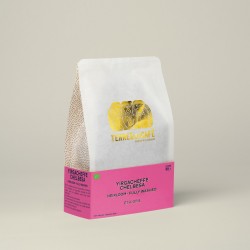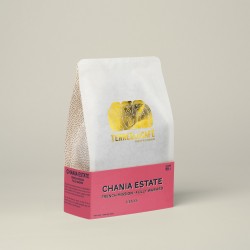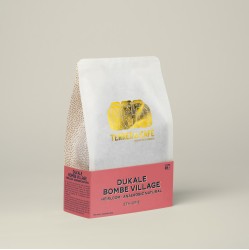The fermentation stage is the first transformation process of coffee. The berry is made up of a husk, mucilage or pulp, which is fact the flesh of the fruit, and the parchment that protects the coffee bean and which is itself coated in the siverskin.
Fermentation consists of eliminating the mucilage around the parchment. It must be perfectly controlled so as not to cause major faults in the batch, like a taste of potato, onion or of rot. The choice of the fermentation method will determine the cup profile :
Dry or natural processing

As soon as they are taken to the farm or cooperative, the whole beans are spread out onto concrete areas at the worst or better, tiled areas or ideally on African beds to dry in the sun for several days. During this drying period, the faulty beans - berries that are green, damaged, bitten by insects, etc. – are sorted on the bed.
The coffee will then remain as parchment coffee before being definitively sorted. Homogeneous fermentation requires high precision: the right drying time, absolute aeration, a single layer of berries, frequent mixing, covered during the night and uncovered with the first rays of sunshine.
Profile: dry processing of coffees – fermentation having been performed with the whole pulp – these coffees have a sweetened cup profile with body and a high degree of typicity.
A traditional method of fermentation, then for a long period used as a method for low quality coffee only because less technical and laborious, this method is now becoming a more standard method with specialty coffee producers due to its cup profile which combines power, gourmandise and character.
Honey Process or Pulped Natural process
Recent and becoming very popular, this method is intermediate between dry and wet processes. The coffee is received as cherries, is directly, partially or fully pulped then leaves immediately for the drying beds. There are different types of Honey Processes depending on the quantity of pulp left adhering to the parchment. The greater the quantity of pulp, the longer the time of drying:
- Black Honey - almost all the pulp
- Red Honey – between 50% and 90% of pulp
- Yellow Honey - between 50% and 75% of pulp
- White Honey – between 10% and 20 % of pulp
Profile: A logically intermediate profile, the coffees keep their roundness, body and typicity but have improved elegance and finesse. When more mucilage is left, the greater is the tendency toward sweet and characteristic coffees, when there is less, finesse and acidity are ascendant. -
Wet or washed process
Washed or fully washed coffee
As soon as the cherries are received they are plunged into tanks or siphons filled with water. Floating, defective cherry bodies will be put aside for the dry fermentation process. The others will go through a pulping machine that will remove the husk and some of the mucilage. They will then be soaked in water tanks, called fermentation tanks for from 24 to 48 hours after which the mucilage will have completely disappeared. The water furthermore enables the fermentation temperature to be regulated and the elimination of some of the caffeine contained in the coffee bean.
The coffee will then be dried as parchment in the sun in compliance with the same criteria as for the dry process for the best. Drying can also be achieved in rotary ovens at low temperatures (approximately 30°C) but in compliance with strict rules to ensure homogeneous drying. This ensures good distribution of water in the bean (water energy) and favours conservation and quality roasting. There again, precision must be in tune with defined and controlled fermentation times, with totally clean and routinely serviced tanks, with critical water masses depending on the coffee mass and subject to frequent mixing.
Profile: Cup profile is more focused on purity and precision, the fruit's substance is less corpulent but more delicate. This method requires an adequate infrastructure and much water. Much used in Latin America, it remains a channel of choice for the now world-wide specialty coffees because it reveals the full purity and the finesse of the best Arabicas.
Double washed is the same method as for washed coffees but before drying the coffees after they have stood in the fermentation tank, they are re-soaked and allowed to stand in tanks containing clear water for several hours;
This method also bears the appellation Kenyan but has started to be used in Central America seeing that the purity and acidity results are impressive. Profile: ultra-pure cup where fruity acidity is by far the most significant character. Semi Washed: This method consists of using the same method as for washed coffee without it standing in fermentation tanks.
The coffee, once the mucilage is removed, will be directly dried in the sun followed, if necessary, by oven drying. This method has the advantage of using less water, less costly infrastructures and requires less space. Profile: An increase in mouthfeel is offset by a slight loss of purity but the cup is totally correct and elegant.

TERRES DE CAFE
Roasted with goodness



